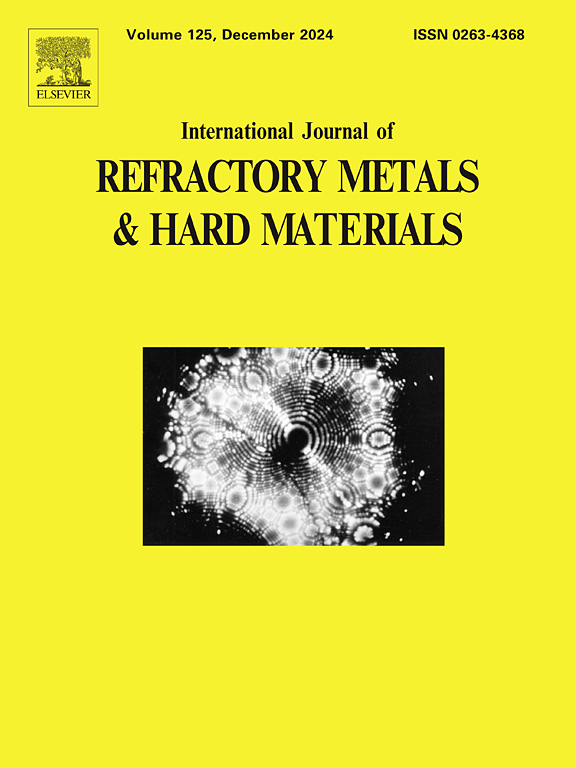重过渡金属诱导高硬度岩盐结构碳化钽的超导性
IF 4.2
2区 材料科学
Q2 MATERIALS SCIENCE, MULTIDISCIPLINARY
International Journal of Refractory Metals & Hard Materials
Pub Date : 2025-07-20
DOI:10.1016/j.ijrmhm.2025.107340
引用次数: 0
摘要
人们普遍认为,传统超导体中的强电子-声子耦合主要是由轻元素的高振动频率引起的。在这项工作中,我们报告了一个异常超导系统,其中共价金属化合物TaC的超导行为主要来自重过渡金属原子。采用高压高温(HPHT)技术合成了共价金属TaC(空间基团Fm-3 m)的多晶样品。通过直接磁化率和电阻率测量的综合表征证实,TaC具有弱耦合ii型超导体的特征,具有非常高的上临界磁场和9.0 K的超导转变温度(Tc)。有趣的是,该材料表现出优异的机械性能,其渐近维氏硬度值明显超过传统超导材料。Ta:C = 1:9 .9的组合物表现出最佳的性能平衡,在保持稳定超导转变特性的同时,最大维氏硬度达到18.7 GPa。第一性原理计算表明,Tc的升高主要源于钽原子的大量电子贡献。我们的研究结果表明,控制碳空位的引入是定制这些双重功能特征的有效策略,为开发能够在极端机械和电磁条件下工作的专用超导器件提供了新的设计原则。本文章由计算机程序翻译,如有差异,请以英文原文为准。
Heavy transition metal induced superconductivity in high hardness rock-salt structure tantalum carbide
It is widely acknowledged that strong electron-phonon coupling in conventional superconductors predominantly arises from the high vibrational frequencies of light elements. In this work, we report an anomalous superconducting system where the superconducting behavior in the covalent metallic compound TaC originates predominantly from heavy transition metal atoms. Polycrystalline samples of the ‘covalent metal’ TaC (space group Fm-3 m) were synthesized using a high-pressure high-temperature (HPHT) technique. Comprehensive characterization through direct magnetic susceptibility and electrical resistivity measurements confirms that TaC exhibits characteristics of a weakly-coupled type-II superconductor, demonstrating both a remarkably high upper critical magnetic field and a superconducting transition temperature (Tc) of 9.0 K. Intriguingly, the material displays exceptional mechanical properties as evidenced by its asymptotic Vickers hardness values, which significantly surpass these of conventional superconducting materials. The composition with Ta:C = 1:0.9 demonstrates optimal performance balance, achieving a maximum Vickers hardness of 18.7 GPa while maintaining robust superconducting transition characteristics. First-principles calculations reveal that the elevated Tc primarily stems from substantial electronic contributions from tantalum atoms. Our findings demonstrate that controlled introduction of carbon vacancies serves as an effective strategy for tailoring these dual functional characteristics, providing novel design principles for developing specialized superconducting devices capable of operating under extreme mechanical and electromagnetic conditions.
求助全文
通过发布文献求助,成功后即可免费获取论文全文。
去求助
来源期刊
CiteScore
7.00
自引率
13.90%
发文量
236
审稿时长
35 days
期刊介绍:
The International Journal of Refractory Metals and Hard Materials (IJRMHM) publishes original research articles concerned with all aspects of refractory metals and hard materials. Refractory metals are defined as metals with melting points higher than 1800 °C. These are tungsten, molybdenum, chromium, tantalum, niobium, hafnium, and rhenium, as well as many compounds and alloys based thereupon. Hard materials that are included in the scope of this journal are defined as materials with hardness values higher than 1000 kg/mm2, primarily intended for applications as manufacturing tools or wear resistant components in mechanical systems. Thus they encompass carbides, nitrides and borides of metals, and related compounds. A special focus of this journal is put on the family of hardmetals, which is also known as cemented tungsten carbide, and cermets which are based on titanium carbide and carbonitrides with or without a metal binder. Ceramics and superhard materials including diamond and cubic boron nitride may also be accepted provided the subject material is presented as hard materials as defined above.

 求助内容:
求助内容: 应助结果提醒方式:
应助结果提醒方式:


